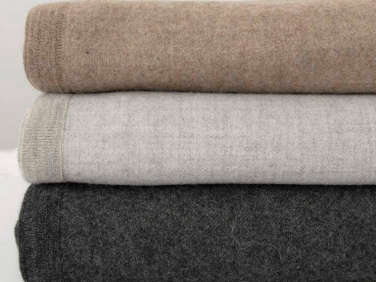New York–based Swedish designer Anki Spets has been making luxuriously minimalist bed linens for the past 25 years. I discovered her company Area via my favorite cotton blanket, the herringbone-patterned Harry, which has long been synonymous with summer in my house. More recently, I’ve met Anki in person at design shows, and each time we cross paths, I ask her for insider tips on linens care. After several of these discussions, she presented me with her How Best to Wash Bedding primer.

Washing Rules
1. Remove any spots before the textile goes in the washer–once they’ve been cooked and baked, they’re permanent. Oily grease stains from body lotion, etc., are common on sheets. Remove them with dish soap: Wet the spot, apply soap, and, if the fabric isn’t fragile, massage in or scrub with a nail brush before washing.
2. Prepping the laundry is important: Button buttons, close Velcro (so it doesn’t get stuck on other things), and turn patterned or decorated fabrics inside out.

3. Do not mix bedding with clothes that have metal zippers or a rough texture—they can cause pilling and abrasion.
4. Use less detergent than the manufacturer recommends: Too much detergent weakens fibers over time. I like Ecover from the supermarket and I’ve been thinking about splurging on Swedish natural laundry soap lines L:A Bruket and Tangent.

5. Fill the washer with water and detergent before adding laundry, so that the detergent is diluted when clothes are added. Do not put detergent directly on fabrics; straight detergent can cause discoloration.
6. Do not use fabric softeners; they coat the natural fibers and break them down. The same goes for dryer sheets: Lint sticks to them and causes abrasion inside the dryer that can create pilling.
7. Bleach is not allowed, even so-called “safe bleach.” And some personal care products, such as acne medications and toothpastes that contain oxidizing agents, can discolor pillowcases and sheets with bleach spots. So can accidental splatters and sprays of floor polishing liquid.
8. Wash in warm or cold water–lower temperatures are good for the environment and detergents work well these days, so less hot water is needed. In Sweden, you can set your washing machine temperature at 30, 40, 60, and 90 degrees Celsius–90 is close to boiling and these days to save energy, whites typically go in at 60 and most other stuff at 40.
Drying Rules
1. Line dry sheets and duvet covers if you can. (Out the window and across the street isn’t an option on 21st Street, where I live, but I wish it were.)

2. If using a dryer, take the sheets out before they’re completely dry. Drape them on a drying rack and then just stretch out and fold: This is a two-person job, and the stretching is nearly as effective as ironing.
3. For cotton blankets, the dryer is also the way to go–air dried they can feel crusty and lose their fluff. But be sure to use a low setting and take them out before they’re completely dry.
4. A too-hot dryer is what ruins most fabrics. Hot water is not a problem, but a hot dryer weakens and breaks natural fibers. The last minutes of the dryer cycle are when fabric overheats, making it brittle and faded over time. Overheating also makes fabrics staticky, which attracts dust.
5. Cleaning the lint filter is a must for blankets and other soft surface textiles. If allowed to accumulate, lint creates a type of pilling on surfaces.


The Case for Ironing
1. Linen gets softer with ironing and I find ironing sheets therapeutic–try it and I think you’ll agree, but if you don’t have time, just iron the pillowcases. Linen is best ironed when damp.
2. For the ultimate pressed sheets, consider an old-fashioned mangle. Apartment buildings in Stockholm have them in the laundry rooms: You fold the sheet lengthwise and guide it between two rollers. Owning one is on my wish list.

Other Tips
- These days, most linen on the market is pre-washed for a more lived-in feel and appearance; it can be dried in the dryer. But traditional, untreated linen should never go in the dryer—the heat causes the fiber to close up and lose its luster.
- Wool blankets and throws should be periodically aired outdoors if possible or in an open window. This keeps them fresh. Wool should be hand-washed (but not too often). Lie flat to dry, and to iron, cover with a moist cotton or linen cloth (this presses the wool without harming it or creating a shine). Any other fabric you’re not sure of can be successfully pressed with this technique.
- Storing linens in plastic can result in yellowing and should be avoided. Natural fibers need to be able to breathe.
- Consider double pillowcases: I keep a basic white cotton cover over my down pillows as extra protection for both pillow and pillowcase.
- Skip the top sheet. Instead do what we do in Sweden and use a cotton or linen duvet cover in place of a top sheet. (In cold weather, a down- or wool-filled comforter is great. When it gets warm out, we swap in a lightweight quilt or cotton blanket inside the duvet cover.) Think of it: All you have to do is unfurl the duvet and your bed is made.

Take a look at Laundry Rooms—we have a lot of favorites, including Steal This Look: Simple Summer Laundry Room.
N.B. This post is an update; the original post ran on June 26, 2015.
Want more cleaning solutions?
- Erin whips up her own Windex substitute in Shine Bright Like a Diamond: Window-Cleaning Edition.
- Alexa shares her favorite 12 Natural Garment Washes and Detergents.
- Justine discovers How to Whiten Your Sheets with Laundry Bluing.










Have a Question or Comment About This Post?
Join the conversation (29)